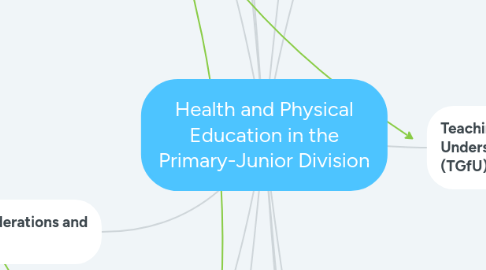
1. COMMUNICATION with Students
2. Teachers' Tools for Teaching Health and Physical Education
2.1. OPHEA
2.2. Resources
2.3. Ontario Curriculum - Health and Physical Education
2.4. Public Health Department of Ontario
3. Classroom Practices
3.1. Daily Physical Activity
3.1.1. Approximately 20 Minutes/Day
3.1.1.1. Three Part DPA
3.1.1.1.1. Warmup (3-5 Minutes)
3.1.1.1.2. Moderate/High Intensity Activity (10-12 Minutes)
3.1.1.1.3. Cool Down (3-5 Minutes)
3.1.2. Accessible for ALL STUDENTS
3.2. Considerations for Bodily-Kinesthetic Learners
3.3. Modifications, Variations and Differentiated Instructions
3.3.1. Know Your Students
3.4. Cross Curricular/ Curriculum Links
3.5. Assessment and Evaluation
3.5.1. Assessment FOR
3.5.1.1. Diagnostic, adaptive and instructional approaches to student needs - Coach
3.5.2. Assessment AS
3.5.2.1. To engage in peer or self assessment as they are learning - Coach
3.5.3. Assessment OF
3.5.3.1. Evaluation and summative assessment of overall expectations - Judge
3.6. Diagnostics and Entry-Level Assessment
3.7. Proper and Safe Equipment
3.8. Communicate Expectations with Students
3.9. Be Familiar and Comfortable with Sensitive Topics
4. Safety Considerations and Practices
4.1. Safety Protocals
4.2. Student Safety is the #1 Priority
4.3. SUPERVISION
4.4. Facility Safety
4.5. Know the Location and, if possible, the Use of First Aid Equipment
4.5.1. Ensure First Aid Kit is Accessible
4.6. Know any Student Health Considerations and Conditions
4.6.1. And any Equipment required
4.7. Provide Clear and Concise Instructions
4.8. Consider Risks, Hazards and Possible Injuries
5. Reflection
5.1. Emotions Towards Health and Physical Education
5.2. Positive and/or Negative Experiences with Health and Physical Education
5.3. Likes and Dislikes about Health and Physical Education
6. Ontario Curriculum - Health and Physical Education
6.1. Fundamental Concepts in Health and Physical Education
6.1.1. 1. Health and physical education programs are most effective when they are delivered in healthy schools and when students’ learning is supported by school staff, families,and communities.
6.1.2. 2. Physical activity is the key vehicle for student learning.
6.1.3. 3. Physical and emotional safety is a precondition for effective learning in health and physical education.
6.1.4. 4. Learning in health and physical education is student-centred and skill-based.
6.1.5. 5. Learning in health and physical education is balanced, integrated, and connected to real life.
6.2. Curriculum Strands
6.2.1. Strand A - Social-Emotional Learning Skills
6.2.2. Strand B - Active Living
6.2.3. Strand C - Movement Competence: Skills, Concepts and Strategies
6.2.4. Strand D - Healthy Living
7. Healthy Active Living
7.1. Personal Beliefs
7.2. Personal Values
7.3. Personal Practice
7.4. Mental and Emotional Health
7.5. Physical Literacy
7.5.1. Individuals who are physically literate move with competence and confidence in a wide variety of physical activities in multiple environments that benefit the healthy development of the whole person.
7.5.2. Motivation
7.6. Health Literacy
7.6.1. Health literacy involves the skills needed to get, understand and use information to make good decisions for health.
7.7. Mind and Body Connection
7.7.1. Release of Endorphins
7.7.2. Reduce Muscle Tension
7.7.3. Enhances Neurogenesis
7.8. Active Participation
7.9. Physical Fitness and Endurance
8. Physical Skills Development
8.1. Gross Motor Skills
8.2. Exists on a CONTINUUM
9. Teaching Games for Understanding (TGfU)
9.1. Basic Concept
9.1.1. Teaches Games through Games
9.1.2. Breaks Games into their Simplest Format - and then increase Complexity
9.1.3. Games need to be Age and Competence Appropriate
9.2. TGfU Categories
9.2.1. Target
9.2.2. Net/Wall
9.2.3. Striking/Fielding
9.2.4. Territory
9.2.5. Individual Pursuits
9.3. Tactical Skills Development
9.3.1. Rules and Strategies that are Required to be Successful in a Game
9.3.2. Activities aim to emphasize skill execution and acquisition
9.3.3. Activities used for skill application and transfer of knowledge of those skills
9.4. Technical Skills Development
9.4.1. Skills of the Game
9.4.2. Activities aim to emphasize skill execution and acquisition
9.4.3. Activities used for skill application and transfer of knowledge of those skills
9.5. Materials and Equipment OTHER than those used for designated sports
10. Equity, Diversity and Social Justice Values (EDSJ)
10.1. Learner-Centered
10.2. Privacy
10.3. Acceptance and Inclusion of ALL Students
10.4. Honours and Respects ALL Students
10.5. Whole-School Approach
10.5.1. Responsibility of:
10.5.1.1. Teachers
10.5.1.2. Government
10.5.1.3. Administration
10.5.1.4. Parents/ Guardians
10.5.1.5. Community

